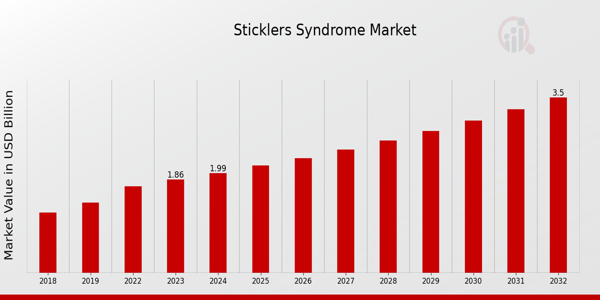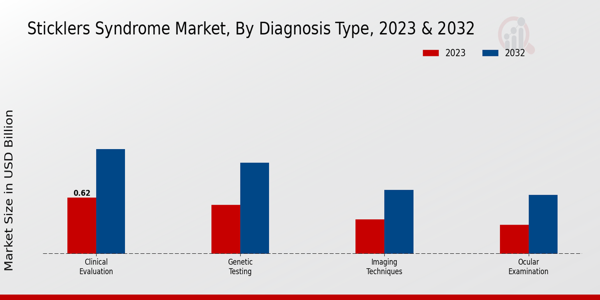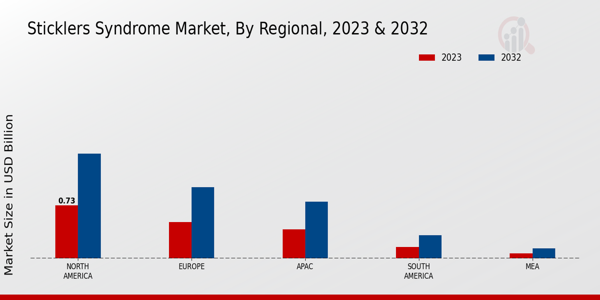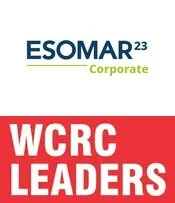Sticklers Syndrome Market Overview
As per MRFR analysis, the Sticklers Syndrome Market Size was estimated at 1.73 (USD Billion) in 2022.
The Sticklers Syndrome Market Industry is expected to grow from 1.86(USD Billion) in 2023 to 3.5 (USD Billion) by 2032. The Sticklers Syndrome Market CAGR (growth rate) is expected to be around 7.3% during the forecast period (2024 - 2032).
Key Sticklers Syndrome Market Trends Highlighted
The Sticklers Syndrome Market is registering growth on the back of increased awareness regarding genetic diseases along with an increase in the knowledge of genetic testing technologies. The shrinking of the diagnosis gap, combined with the increasing need for custom-tailored treatment protocols, created a greater need for therapies and interventions. Furthermore, the growing concern of the providers towards early intervention adds to the burgeoning popularity of this niche market. Moreover, government support and investment in the research of this particular subset of genetic diseases are additional contributors to growth. The areas which hold the most prospective business opportunities include the establishment of advanced remedial measures and total management of patients.There is a significant potential for collaboration between pharmaceutical companies and research institutions to create new treatment options tailored to the specific needs of Sticklers Syndrome patients. Furthermore, increasing efforts to educate healthcare professionals about the syndrome can enhance diagnostic rates and improve patient outcomes. The global reach of telemedicine can also facilitate access to rare disease specialists, broadening the scope for patient engagement and care. Recent trends in the market showcase advancements in gene editing technologies, which hold promise for treating genetic disorders at the molecular level. The rise in telehealth services is making it easier for patients to connect with specialists and receive critical care.Research initiatives focusing on biomarkers for Sticklers Syndrome are also emerging, which could pave the way for better diagnostic tools. Overall, the market is experiencing a shift towards more integrated healthcare solutions, emphasizing patient-centric strategies that address both the medical and emotional needs of individuals affected by this condition. By capitalizing on these trends, stakeholders can make significant strides in improving the quality of life for patients with Sticklers Syndrome.

Source: Primary Research, Secondary Research, MRFR Database and Analyst Review
Sticklers Syndrome Market Drivers
Increasing Awareness and Diagnosis of Sticklers Syndrome
The Sticklers Syndrome Market Industry is experiencing significant growth driven by the increasing awareness and diagnosis of this rare genetic disorder. As healthcare providers and families become more informed about Sticklers Syndrome, the identification of symptoms and the need for early intervention are on the rise. This heightened awareness helps in diagnosing the condition earlier in patients, which is crucial for effective management and treatment.Enhanced education initiatives and advocacy by various health organizations are contributing to the broader understanding of Sticklers Syndrome among both medical professionals and the general public. Furthermore, as healthcare systems improve their diagnostic capabilities, it becomes easier to identify individuals who may be suffering from this condition, leading to a greater demand for treatment options and management solutions. The Sticklers Syndrome Market Industry is also benefiting from technological advancements in genetic testing, enabling more accurate identification of the disorder at an earlier stage.These factors combined are expected to significantly boost market growth as the number of diagnosed patients increases and the demand for targeted therapies rises, reflecting a shift in focus towards personalized medicine. As patients increasingly seek more information and options regarding their health, the market will likely see a continued expansion of resources, such as genetic counseling and specialized healthcare services tailored to individuals with Sticklers Syndrome, aiding in market development further.
Rising Investments in Research and Development
The Sticklers Syndrome Market Industry is bolstered by rising investments in research and development (R) aimed at better understanding and treating this condition. Pharmaceutical companies and research institutions are increasingly committing resources towards the exploration of innovative therapies that address the unique challenges associated with Sticklers Syndrome. This focus on R not only enhances the development of new treatment options but also fosters collaboration between clinical researchers and geneticists, which is essential for advancing knowledge about this rare disorder.Moreover, government and private sector funding dedicated to rare diseases has seen a notable rise, further propelling the growth of R&D activities in the field.
Growing Demand for Personalized Medicine
The shift towards personalized medicine is creating additional opportunities within the Sticklers Syndrome Market Industry. Patients increasingly seek treatments that are tailored to their genetic makeup and individual health needs. This demand for customization drives pharmaceutical companies to develop personalized therapies that could significantly improve treatment outcomes for those affected by Sticklers Syndrome. The growth of genetic profiling technologies and biomarker assessments allows for more precise targeting of therapies, enhancing the potential for effective management of the condition and enabling healthcare providers to offer more individualized treatment plans.
Sticklers Syndrome Market Segment Insights
Sticklers Syndrome Market Diagnosis Type Insights
The Sticklers Syndrome Market, particularly under the Diagnosis Type segment, is experiencing noteworthy progression, with the 2023 valuation standing at 1.86 USD Billion and expected to reach 3.5 USD Billion by 2032, showcasing a strong growth pathway. The segmentation within this market includes Clinical Evaluation, Genetic Testing, Imaging Techniques, and Ocular Examination, each playing a critical role in the diagnosis and management of Sticklers Syndrome. Among these, Clinical Evaluation holds a majority share, valued at 0.62 USD Billion in 2023 and projected to increase to 1.15 USD Billion by 2032, emphasizing its significant role in the thorough assessment of patients exhibiting symptoms of the syndrome.This segment dominates primarily due to the reliance on comprehensive patient history and physical examinations that are fundamental in initial diagnosis. Genetic Testing follows closely behind, valued at 0.54 USD Billion in 2023 and expected to rise to 1.0 USD Billion by 2032. The increasing recognition of genetic markers associated with Sticklers Syndrome makes Genetic Testing a pivotal diagnostic tool, thus enhancing its relevance and significance in the healthcare landscape. Imaging Techniques, with a value of 0.38 USD Billion in 2023 and a forecasted increase to 0.7 USD Billion by 2032, play an essential role in visualizing structural anomalies related to the disorder, contributing to the overall diagnostic accuracy.This segment's growth can be attributed to advancements in medical imaging technologies that allow for clearer, more detailed analysis, which is crucial for tailoring patient-specific treatment plans. Lastly, Ocular Examination, though valued at 0.32 USD Billion in 2023 with anticipated growth to 0.65 USD Billion by 2032, is focused on the assessment of ocular manifestations common in Sticklers Syndrome, verifying its necessity but highlighting it as the least dominant segment within the diagnosis segment. The integration and advancement of these diagnostic methods reflect the market's response to the increasing need for early and accurate detection of Sticklers Syndrome, reinforcing the importance of continued innovation and research in this niche medical field.Overall, the Sticklers Syndrome Market segmentation points towards a robust increase in awareness and resource allocation for effective diagnostic strategies across various methodologies.

Source: Primary Research, Secondary Research, MRFR Database and Analyst Review
Sticklers Syndrome Market Symptoms Insights
The Sticklers Syndrome Market's Symptoms segment plays a crucial role in understanding the overall impact of this condition, projected to be valued at 1.86 billion USD in 2023. This segment encompasses various manifestations, including Ocular Symptoms, Auditory Symptoms, Musculoskeletal Symptoms, and Cardiac Symptoms. The distribution and impact of these symptoms significantly influence the market landscape, with Ocular Symptoms often being a predominant concern, leading to complications like retinal detachment. Auditory Symptoms also represent a major issue, frequently resulting in hearing loss that affects the quality of life.Musculoskeletal Symptoms contribute greatly to physical impairment and chronic pain, affecting patient mobility. Additionally, Cardiac Symptoms, although less common, can result in severe complications, indicating a need for targeted therapies. The Sticklers Syndrome Market is influenced by rising awareness and the demand for specialized healthcare services, presenting opportunities for growth in treatment options tailored to these symptoms. Understanding this segment is vital for stakeholders aiming to enhance patient management and therapeutic outcomes in the evolving Sticklers Syndrome Market industry.
Sticklers Syndrome Market Treatment Type Insights
The Sticklers Syndrome Market, valued at 1.86 billion USD in 2023, is a critical focus area in the healthcare industry, particularly regarding the Treatment Type segment. This market encompasses various therapeutic categories, including Surgical Interventions, Medication, Physical Therapy, and Regular Monitoring, each playing a vital role in managing Sticklers Syndrome. Surgical Interventions often serve as a cornerstone for patients requiring immediate corrective measures, underscoring the importance of advanced surgical techniques and technology.Meanwhile, Medication remains vital for symptom management and improving quality of life, allowing patients to navigate daily challenges effectively. Physical Therapy is recognized for its role in enhancing mobility and functionality, catering to the needs of individuals facing physical limitations. Regular Monitoring is crucial in the ongoing evaluation of patient health and treatment efficacy, fostering timely interventions. Collectively, these elements contribute significantly to the Sticklers Syndrome Market revenue, reflecting a well-rounded approach toward comprehensive patient care.The market is expected to observe notable growth driven by technological advancements, increasing awareness, and the rising incidence of Sticklers Syndrome, providing lucrative opportunities in the healthcare landscape.
Sticklers Syndrome Market Patient Age Group Insights
The Sticklers Syndrome Market is experiencing notable growth, with a projected market value of 1.86 billion USD in 2023. This market segmentation by Patient Age Group plays a vital role in the overall industry dynamics. Within this segment, the Pediatric group often holds a significant share due to the early onset of Sticklers Syndrome in children, making timely diagnosis and treatment imperative. Meanwhile, the Adult population represents a major portion of the market as individuals often face diagnosed cases later in life, leading to increased demand for medical interventions.The Geriatric age group has also gained attention as older adults may experience complications associated with Sticklers Syndrome, driving healthcare services tailored to their needs. Together, these segments highlight important growth drivers, as advancements in healthcare technology and increasing awareness about Sticklers Syndrome are facilitating effective treatments for all age groups. The emerging opportunities within these demographics present significant potential for market players, all contributing to the enhanced Sticklers Syndrome Market data and statistics that underscore the industry's potential for expansion in the coming years.
Sticklers Syndrome Market Regional Insights
The Sticklers Syndrome Market is seeing significant growth, with North America leading as the dominant segment, valued at 0.73 USD Billion in 2023 and projected to reach 1.44 USD Billion by 2032. This region's high market share is attributed to increased awareness and advanced healthcare infrastructure. Europe follows, with a value of 0.50 USD Billion in 2023, anticipated to grow to 0.98 USD Billion by 2032, indicating robust investments in medical research. The APAC region is also notable, with a valuation of 0.40 USD Billion in 2023 and a rise to 0.78 USD Billion by 2032, showcasing growing healthcare access and rising diagnostic capabilities.South America and MEA represent the smaller segments, valued at 0.16 USD Billion and 0.07 USD Billion in 2023, respectively, with both regions expected to see steady growth. Overall, the Sticklers Syndrome Market revenue growth across these regions is fueled by technological advancements, increasing healthcare expenditure, and a rise in patient awareness, along with ongoing research into genetic disorders. The market growth presents opportunities for stakeholders to enhance their offerings and tap into the expanding patient base globally.

Source: Primary Research, Secondary Research, MRFR Database and Analyst Review
Sticklers Syndrome Market Key Players and Competitive Insights
The Sticklers Syndrome Market is characterized by a notable array of competitors striving to establish their presence in the field of rare genetic disorders. This market remains relatively niche, dominated by companies that specialize in the development of therapies and treatments aimed at managing the symptoms associated with Stickler Syndrome. Advanced research initiatives, innovative treatment approaches, and collaborative efforts among research institutions and pharmaceutical companies shape the competitive landscape. As awareness of Stickler Syndrome increases, the market is witnessing heightened competition, with various players aiming to introduce groundbreaking solutions tailored to enhance patient care and improve the quality of life for those diagnosed with this condition. Companies are investing heavily in clinical trials, resulting in the introduction of new therapies, diagnostics, and supportive treatments that hold promise for affected individuals.In the context of the Sticklers Syndrome Market, Pfizer has established a significant foothold characterized by its commitment to research and innovation. The company's extensive portfolio encompasses a wide range of therapeutic areas, including rare diseases, which positions it advantageously in addressing the complexities of Stickler Syndrome. Pfizer's robust research capabilities allow it to explore the underlying mechanisms of genetic disorders, enabling the development of targeted therapies that could effectively manage Stickler Syndrome. The company's strong emphasis on collaborations with academic institutions and research organizations facilitates the acceleration of clinical trials and enhances its ability to bring new treatments to market. With a strong brand reputation and a deep understanding of patient needs, Pfizer's presence in the market is marked by a strategic focus on advancing treatment options and improving patient outcomes.Amgen's involvement in the Sticklers Syndrome Market reflects its dedication to advancing biopharmaceutical innovations aimed at rare genetic conditions. The company is renowned for its expertise in biotechnology and its capacity to develop biological therapies that address unmet medical needs. Amgen leverages its cutting-edge research facilities and extensive pipeline to investigate therapies that combat the complexities of Stickler Syndrome. The company emphasizes patient-centric approaches, striving to understand the specific needs of individuals living with this rare disorder. Through collaborations with healthcare providers and advocacy organizations, Amgen aims to enhance educational initiatives that promote awareness and understanding of Stickler Syndrome. Its commitment to rigorous clinical research ensures that Amgen remains at the forefront of discovering effective treatments, thereby contributing to the overall advancement of care for patients affected by this condition.
Key Companies in the Sticklers Syndrome Market Include
- Pfizer
- Amgen
- Merck
- Genentech
- Eli Lilly
- Celgene
- AbbVie
- Vertex Pharmaceuticals
- Roche
- AstraZeneca
- Novartis
- Bristol-Myers Squibb
- Regeneron Pharmaceuticals
- Gilead Sciences
- Sanofi
Sticklers Syndrome Market Industry Developments
The Sticklers Syndrome Market has recently seen significant developments, particularly in the realms of research and corporate activity among major pharmaceutical companies. Pfizer and Roche are actively advancing their product pipelines aimed at addressing the various manifestations of Sticklers Syndrome, focusing on genetic therapies and innovative treatment modalities. Merck and Genentech are collaborating on research studies to better understand the syndrome's pathophysiology, with hopes to improve patient outcomes.
In addition to ongoing clinical trials, there has been a noticeable increase in market valuations for companies like AbbVie and Amgen, spurred by their commitment to developing targeted therapies that cater specifically to genetic disorders like Stickler Syndrome. This escalation in valuation signals growing investor confidence in the potential for pharmacological solutions. Recent industry analyses indicate that merger and acquisition activity may also play a key role in shaping the market landscape, yet current details of such transactions involving companies like AstraZeneca and Bristol-Myers Squibb have not been publicly announced. Overall, the interest among these top-tier firms and their ongoing investments reflect a heightened focus on the clinical challenges posed by Sticklers Syndrome.
Sticklers Syndrome Market Segmentation Insights
Sticklers Syndrome Market Diagnosis Type Outlook
- Clinical Evaluation
- Genetic Testing
- Imaging Techniques
- Ocular Examination
Sticklers Syndrome Market Symptoms Outlook
- Ocular Symptoms
- Auditory Symptoms
- Musculoskeletal Symptoms
- Cardiac Symptoms
Sticklers Syndrome Market Treatment Type Outlook
- Surgical Interventions
- Medication
- Physical Therapy
- Regular Monitoring
Sticklers Syndrome Market Patient Age Group Outlook
- Pediatric
- Adult
- Geriatric
Sticklers Syndrome Market Regional Outlook
- North America
- Europe
- South America
- Asia-Pacific
- Middle East and Africa
| Report Attribute/Metric |
Details |
| Market Size 2022 |
1.73(USD Billion) |
| Market Size 2023 |
1.86(USD Billion) |
| Market Size 2032 |
3.5(USD Billion) |
| Compound Annual Growth Rate (CAGR) |
7.3% (2024 - 2032) |
| Report Coverage |
Revenue Forecast, Competitive Landscape, Growth Factors, and Trends |
| Base Year |
2023 |
| Market Forecast Period |
2024 - 2032 |
| Historical Data |
2019 - 2022 |
| Market Forecast Units |
USD Billion |
| Key Companies Profiled |
Pfizer, Amgen, Merck, Genentech, Eli Lilly, Celgene, AbbVie, Vertex Pharmaceuticals, Roche, AstraZeneca, Novartis, Bristol-Myers Squibb, Regeneron Pharmaceuticals, Gilead Sciences, Sanofi |
| Segments Covered |
Diagnosis Type, Symptoms, Treatment Type, Patient Age Group, Regional |
| Key Market Opportunities |
Rising awareness and diagnosis, Advancements in genetic testing, Development of targeted therapies, Increased funding for research, Growing patient advocacy groups |
| Key Market Dynamics |
Increasing genetic awareness, Advancements in diagnostic tools, Rising healthcare expenditure, Growing patient support groups, Expanding therapeutic options |
| Countries Covered |
North America, Europe, APAC, South America, MEA |
Frequently Asked Questions (FAQ) :
The Sticklers Syndrome Market is expected to be valued at 3.5 USD Billion by 2032.
The Sticklers Syndrome Market is projected to have a CAGR of 7.3% from 2024 to 2032.
North America is expected to hold the largest market share, valued at 1.44 USD Billion by 2032.
By 2032, Clinical Evaluation will be valued at 1.15 USD Billion, Genetic Testing at 1.0 USD Billion, Imaging Techniques at 0.7 USD Billion, and Ocular Examination at 0.65 USD Billion.
Major players in the market include Pfizer, Merck, Genentech, Eli Lilly, and Roche, among others.
The APAC region is expected to grow to a market value of 0.78 USD Billion by 2032.
The market value for Europe is projected to reach 0.98 USD Billion by 2032.
The market presents opportunities driven by advances in diagnostics and increasing awareness of Sticklers Syndrome.
By 2032, the estimated market value for South America is expected to reach 0.32 USD Billion.
The market outlook for the MEA region is expected to grow to 0.14 USD Billion by 2032.















